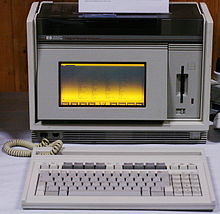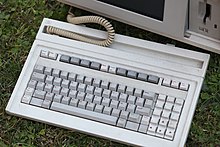
The HP Integral PC (or HP 9807A) is a portable UNIX workstation computer system produced by Hewlett-Packard, launched in 1985 at a price of £5450. [1] It utilizes the Motorola 68000 microprocessor (running at 8 MHz) and ran the HP-UX 1.0 operating system. [2]


The Integral PC is a mains-powered portable computer with a 9-inch amber electroluminescent display with a resolution of 512×255 pixels or 80×25 characters (the 256th line of the display is not used). [3] It also incorporated a 710 kB 3.5" floppy disk drive and an HP ThinkJet ink-jet printer. Standard memory capacity was 256 KB ROM plus 512 KB RAM, expandable to 7.5 MB. [2] Expansion slots and an HP-IB bus were also included. The mechanical design was based on the ideas of the de facto standard HP-85.
Within the Integral PC CPU, RAM, ROM, memory management, I/O buffering, system timing and keyboard interface are integrated on a single logic-board. All peripheral units and the 14 connections are built using independent boards. Each board is smaller than a letter sized sheet. To make it easier to check the boards, each board contains an own timer. The I/O-board (with two connections for optional addons), the keyboard-interface, the "Human Interface Link" HP-HIL and the power supply can be checked and tested independently.
The graphics processor of the Integral PC ( GPU) was custom made and could drive an electroluminescence display or nearly every kind of monitor. The processor provides a graphical subsystem which is simple to use to drive a bitmapped display (32 KB display memory). The GPU is able to draw lines, rectangles and alphanumerical characters by hardware. Additionally it provides a hardware cursor and the display-RAM-interface. [4]
The electroluminescence-display was based on thin-film-technique developed by HP and other companies. [3]
The Integral PC is unusual in that the HP-UX operating system kernel resided in the ROM, [2] which also included the HP Windows graphical user interface and the Personal Applications Manager (PAM). [5] HP-UX commands and utilities were supplied separately on floppy disk, with separate disks for standard Unix commands (including the C shell), utilities, diagnostics and system programming resources. [6] There was an add on ROM that provides HP-BASIC. Using the ROM, the Integral PC was ready to run BASIC simply by switching on the system.
- HP Roman-8 (character set)
- ^ Kewney, Guy (March 1985). "Newsprint". Personal Computer World. p. 99. Retrieved 21 November 2020.
- ^ a b c Fajardo, Ray M.; Rood, Andrew L.; Andreas, James R.; Cline, Robert C. (October 1985). "A UNIX Operating System Adapted for a Technical Personal Computer". Hewlett-Packard Journal. 36 (10): 22–28. Retrieved 4 October 2020.
- ^ a b Higgins, Marvin L. (October 1985). "High-Quality Electroluminescent Display for a Personal Workstation". Hewlett-Packard Journal. 36 (10): 12–17. Retrieved 4 October 2020.
- ^ Heath, Dean M. (October 1985). "Custom Graphics Processor Unit for the Integral PC". Hewlett-Packard Journal. 36 (10): 10–12. Retrieved 4 October 2020.
- ^ Brewster, Jon A.; Helt, Karen S.; Phillips, James N. (October 1985). "A Friendly UNIX Operating System User Interface". Hewlett-Packard Journal. 36 (10): 28–35. Retrieved 4 October 2020.
- ^ Walker, Nick (June 1985). "Hewlett-Packard Integral PC". Personal Computer World. pp. 144–146, 148, 150. Retrieved 12 October 2020.
- Chin, Kathy (21 January 1985). "HP Introduces Unix Portable". InfoWorld. Retrieved 2011-02-17.
- jim (18 March 1985). "HP Integral PC specs". Newsgroup: net.micro.hp. Usenet: 77900002@hp-pcd.UUCP. Retrieved 2011-02-17.

The HP Integral PC (or HP 9807A) is a portable UNIX workstation computer system produced by Hewlett-Packard, launched in 1985 at a price of £5450. [1] It utilizes the Motorola 68000 microprocessor (running at 8 MHz) and ran the HP-UX 1.0 operating system. [2]


The Integral PC is a mains-powered portable computer with a 9-inch amber electroluminescent display with a resolution of 512×255 pixels or 80×25 characters (the 256th line of the display is not used). [3] It also incorporated a 710 kB 3.5" floppy disk drive and an HP ThinkJet ink-jet printer. Standard memory capacity was 256 KB ROM plus 512 KB RAM, expandable to 7.5 MB. [2] Expansion slots and an HP-IB bus were also included. The mechanical design was based on the ideas of the de facto standard HP-85.
Within the Integral PC CPU, RAM, ROM, memory management, I/O buffering, system timing and keyboard interface are integrated on a single logic-board. All peripheral units and the 14 connections are built using independent boards. Each board is smaller than a letter sized sheet. To make it easier to check the boards, each board contains an own timer. The I/O-board (with two connections for optional addons), the keyboard-interface, the "Human Interface Link" HP-HIL and the power supply can be checked and tested independently.
The graphics processor of the Integral PC ( GPU) was custom made and could drive an electroluminescence display or nearly every kind of monitor. The processor provides a graphical subsystem which is simple to use to drive a bitmapped display (32 KB display memory). The GPU is able to draw lines, rectangles and alphanumerical characters by hardware. Additionally it provides a hardware cursor and the display-RAM-interface. [4]
The electroluminescence-display was based on thin-film-technique developed by HP and other companies. [3]
The Integral PC is unusual in that the HP-UX operating system kernel resided in the ROM, [2] which also included the HP Windows graphical user interface and the Personal Applications Manager (PAM). [5] HP-UX commands and utilities were supplied separately on floppy disk, with separate disks for standard Unix commands (including the C shell), utilities, diagnostics and system programming resources. [6] There was an add on ROM that provides HP-BASIC. Using the ROM, the Integral PC was ready to run BASIC simply by switching on the system.
- HP Roman-8 (character set)
- ^ Kewney, Guy (March 1985). "Newsprint". Personal Computer World. p. 99. Retrieved 21 November 2020.
- ^ a b c Fajardo, Ray M.; Rood, Andrew L.; Andreas, James R.; Cline, Robert C. (October 1985). "A UNIX Operating System Adapted for a Technical Personal Computer". Hewlett-Packard Journal. 36 (10): 22–28. Retrieved 4 October 2020.
- ^ a b Higgins, Marvin L. (October 1985). "High-Quality Electroluminescent Display for a Personal Workstation". Hewlett-Packard Journal. 36 (10): 12–17. Retrieved 4 October 2020.
- ^ Heath, Dean M. (October 1985). "Custom Graphics Processor Unit for the Integral PC". Hewlett-Packard Journal. 36 (10): 10–12. Retrieved 4 October 2020.
- ^ Brewster, Jon A.; Helt, Karen S.; Phillips, James N. (October 1985). "A Friendly UNIX Operating System User Interface". Hewlett-Packard Journal. 36 (10): 28–35. Retrieved 4 October 2020.
- ^ Walker, Nick (June 1985). "Hewlett-Packard Integral PC". Personal Computer World. pp. 144–146, 148, 150. Retrieved 12 October 2020.
- Chin, Kathy (21 January 1985). "HP Introduces Unix Portable". InfoWorld. Retrieved 2011-02-17.
- jim (18 March 1985). "HP Integral PC specs". Newsgroup: net.micro.hp. Usenet: 77900002@hp-pcd.UUCP. Retrieved 2011-02-17.